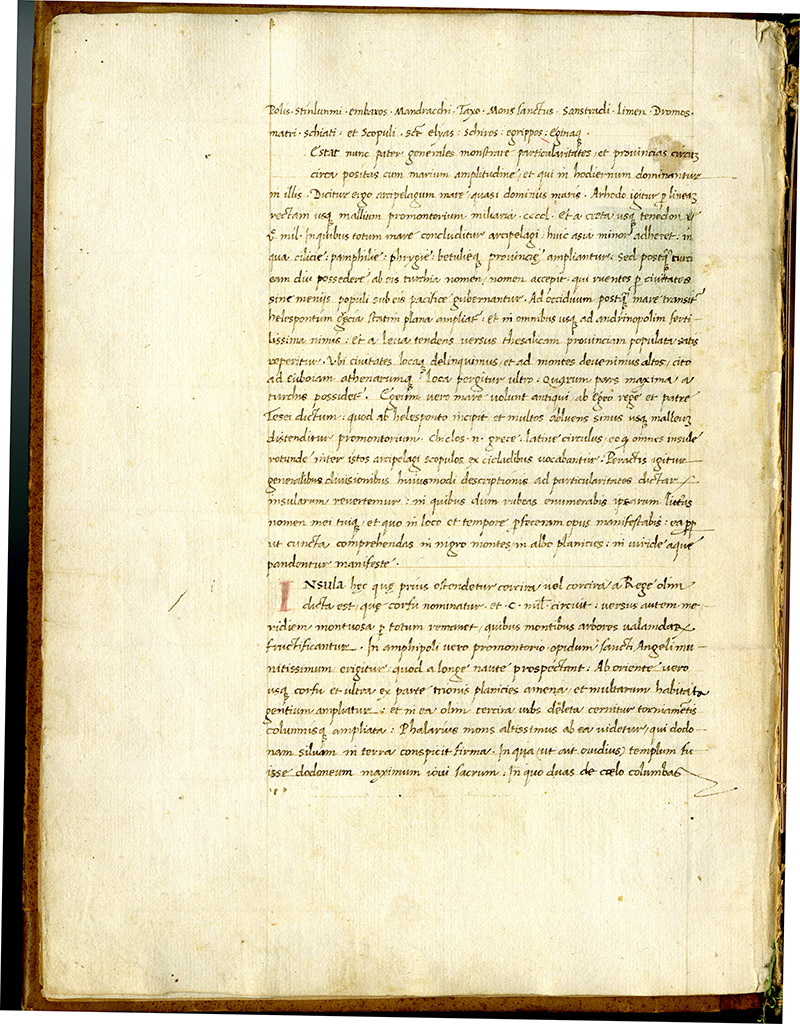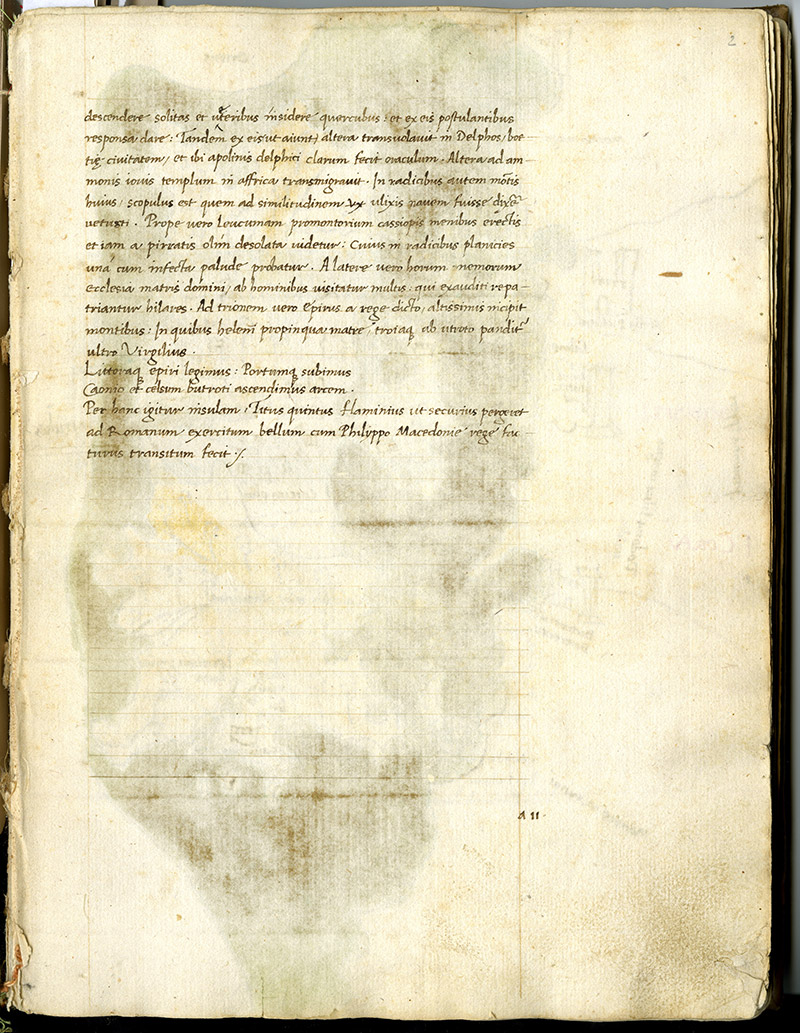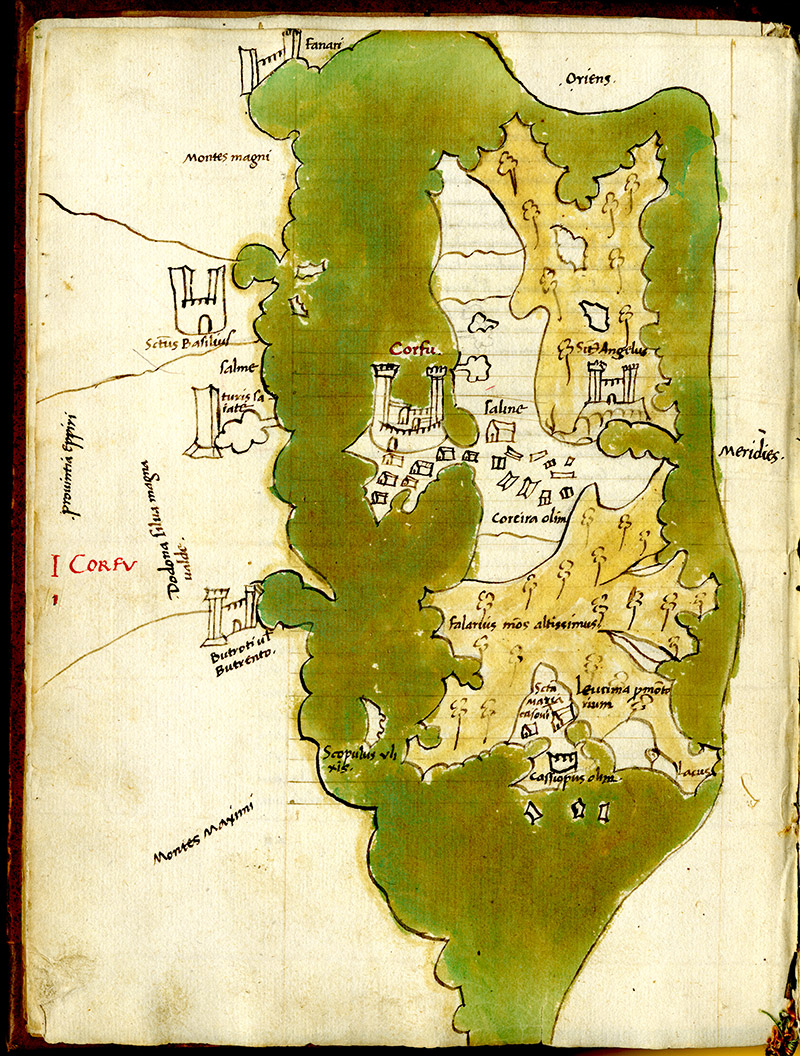Corfù Κέρκυρα
In this section we present the web application which visualizes the data related to the textual description and the map of Corfu in line with one of the final goals of MapAeg which is meant to promote the importance of the Liber Insularum by allowing specialized and non-specialized readers to access its digital edition online.
This tester of what the full digital edition will look like, presents a facsimile of the Gennadios Library, Athens, ms. 71, folios 1 v., 2 r., 2 v.), transcription of the Latin text, English translation, and a commentary accessible on the right side. The map which accompanies the textual description and is already visible in the facsimile reproduction, is presented again in an enlarged view and shown side by side with a contemporary map where corresponding places are geolocated.
For a full discussion of the digital edition and the tester on Corfu, see:
Bessi B and Fusi D: Modelling the Archipelago: Corfu as a Case Study for a Digital Edition of Cristoforo Buondelmonti’s Liber Insularum, Open Research Europe 2024, 4:11, 1-23 (https://doi.org/10.12688/openreseurope.16712.1)
Folios

f. 2 v

f. 3 r

f. 3 v
Latin
English
Insula hec que prius...arum fructificantur.
Insula hec que prius ostendetur cercira vel corcira a Rege olim dicta est, que corfu nominatur. et. C. mil. circuit: versus autem meridiem montuosa per totum remanet, quibus montibus arbores valanidarum fructificantur.
This island which...the oak trees bear fruit.
5This island which is presented first, was once called Kerkyra or Korkyra after a king, and is today called Corfu, and has a perimeter of about 100 miles, its southern part is mountainous and on its mountains the oak trees bear fruit.
In amphipoli vero...longe naute prospectant:
In amphipoli vero promontorio, opidum Sancti Angeli munitissimum erigitur: quod a longe naute prospectant:
On the Amphipolis...can see from far away.
2On the Amphipolis promontory rises the well-fortified castle of Sant’Angelo which sailors can see from far away.
Ab oriente vero...columnisque ampliata:
Ab oriente vero usque corfu et ultra ex parte trionis planicies amena, et multarum habitata gentium ampliatur: et in ea olim cercira urbs deleta cernitur torniamentis columnisque ampliata:
From the east, indeed...of ornaments and columns.
4From the east, indeed, as far as Corfu town and beyond, on the north, a beautiful and densely inhabited plain opens, in which one can see the ancient city of Kerkyra, now in ruins, full of ornaments and columns.
Phalarius mons altis...in terra conspicit firma.
Phalarius mons altissimus ab ea videtur, qui dodona silvam in terra conspicit firma.
From here the very...woods on the mainland.
3From here the very high Mount Phalarius can be seen, which looks towards the Dodonean woods on the mainland.
In qua (ut ait Ovidius)...maximum Iovi sacrum:
In qua (ut ait Ovidius) templum fuisse dodoneum maximum Iovi sacrum:
here, as Ovid says...shrine sacred to Jupiter.
here, as Ovid says, there was the great Dodonean shrine sacred to Jupiter.
In quo duas de coelo...tibus responsa dare:
In quo duas de coelo columbas descendere solitas et veteribus insidere quercubus, et ex eis postulantibus responsa dare:
And in here two...to those who asked.
1And in here two doves would fly down from the sky and settle in the old oak-trees and from there give oracles to those who asked.
Tandem ex eis (ut...clarum fecit oraculum.
Tandem ex eis (ut aiunt) altera transvolavit in Delphos, Boetię civitatem, et ibi apolinis delphici clarum fecit oraculum.
At length, one of...of Delphic Apollo famous.
At length, one of the pair, as they say, flew off to Delphi, a city in Boeotia, and made the oracle of Delphic Apollo famous.
Altera ad ammonis...in Affrica transmigravit.
Altera ad ammonis iovis templum in Affrica transmigravit.
The other migrated...Jupiter Ammon in Africa.
1The other migrated to the temple of Jupiter Ammon in Africa.
In radicibus autem...fuisse dixere vetusti.
In radicibus autem montis huius, scopulus est quem ad similitudinem Ulixis navem fuisse dixere vetusti.
At the foot of this...resembled Odysseus’ ship.
1At the foot of this mountain there is a rock which the ancients said resembled Odysseus’ ship.
Prope vero Leucumam...olim desolata videtur:
Prope vero Leucumam promontorium Cassiopis menibus erectis et iam a pirratis olim desolata videtur:
Near the promontory...uninhabitable by pirates.
2Near the promontory of Leucinna, Kassiopi can be seen with its walls still standing but made uninhabitable by pirates.
Cuius in radicibus...infecta palude probatur.
Cuius in radicibus planities una cum infecta palude probatur.
A latere vero horum...repatriantur hilares.
A latere vero horum nemorum ecclesia matris domini, ab hominibus visitatur multis: qui exauditi repatriantur hilares.
Beside these walls...their countries, happy.
2Beside these walls the church of the Mother of God is visited by many people who, once their prayers have been heard, go back to their countries, happy.
Ad trionem vero...incipit montibus:
Ad trionem vero epirus a rege dicto, altissimis incipit montibus:
on the north begins...with very high mountains.
2on the north begins Epirus, called after a king, with very high mountains.
In quibus heleni...panditur ultro Virgilius.
In quibus heleni propinqua matre, troiaque ab butroto panditur ultro Virgilius.
And in here [of...out further. Virgilius:
3And in here [of Helenus…], and Buthrotum stretches out further. Virgilius:
Litoraque epiri legimus... Portumque subimus
Litoraque epiri legimus: Portumque subimus
Caonio et celsum...butroti ascendimus arcem.
Caonio et celsum butroti ascendimus arcem.
Per hanc igitur insulam...futurus transitum fecit §
Per hanc igitur insulam: Titus quintus Flaminius ut securius pergeret ad Romanum exercitum bellum cum Philippo Macedonie rege futurus transitum fecit §
On this island Titus...Philip of Macedon.
2On this island Titus Quintus Flamininus made a stop to proceed more safely to the Roman army when he was going to make war against Philip of Macedon.
We skirt the shores...Buthrotum’s lofty city.
1We skirt the shores of Epirus, enter the Chaonian harbour, and ascend to Buthrotum’s lofty city.